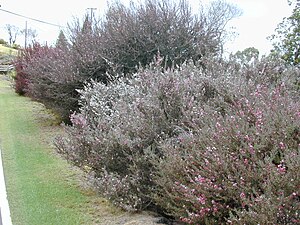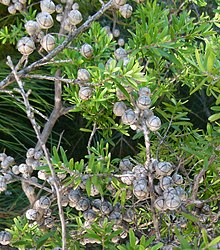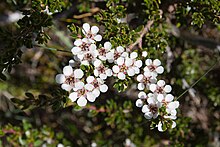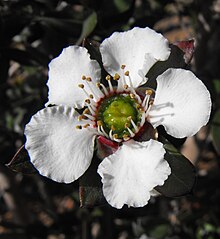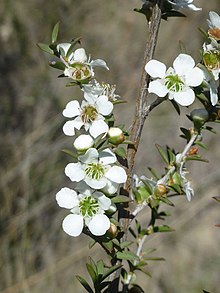-
Leptospermum anfractum A.R.Bean : It wasfirst describedfrom Queensland in 2004.
-
Leptospermum arachnoides Gaertn. (Syn .: Leptospermum arachnoideum Sm. Nom. Illeg., Leptospermum baccatum Sm. , Leptospermum juniperifolium Cav. , Leptospermum triloculare Vent. ): It occurs in the Australian states of Queensland and New South Wales .
-
Leptospermum argenteum Joy Thomps. : It only occurs in New South Wales.
-
Leptospermum barneyense A.R.Bean : It was first described from Queensland of 2004.
-
Leptospermum benwellii A.R.Bean : It is only found in New South Wales.
-
Leptospermum blakelyi Joy Thomps. : It only occurs in New South Wales.
-
Leptospermum brachyandrum (F.Muell.) Druce : It occurs in the Australian states of Queensland and New South Wales.
-
Leptospermum brevipes F. Muell. : It occurs in the Australian states of Queensland, New South Wales, Victoria and the Australian Capital Territory .
-
Leptospermum confertum Joy Thomps. : It wasfirst describedin 1989 from Western Australia .
-
Leptospermum continentale Joy Thomps. : It occurs in the Australian states of South Australia , New South Wales, Victoria and the Australian Capital Territory.
-
Leptospermum coriaceum (F.Muell. Ex Miq.) Cheel (Syn .: Leptospermum laevigatum var. Minus F.Muell. Ex Benth. ): It occurs in the Australian states of South Australia, New South Wales and Victoria.
-
Leptospermum crassifolium Joy Thomps. : It was first described in 1989 from New South Wales.
-
Leptospermum deanei Joy Thomps. : It was first described in 1989 from New South Wales.
-
Leptospermum deuense Joy Thomps. : It was first described in 1989 from New South Wales.
-
Leptospermum divaricatum Schauer (Syn .: Leptospermum trivalve Cheel , Leptospermum trivalvum Cheel orth. Var.): It occurs only in New South Wales.
-
Leptospermum emarginatum H.L.Wendl. ex Link : It occurs in the Australian states of New South Wales and Victoria.
-
Leptospermum epacridoideum Cheel : It is only found in New South Wales.
-
Leptospermum erubescens Schauer : It is only found in Western Australia.
-
Leptospermum exsertum Joy Thomps. : It was first described in 1989 from Western Australia.
-
Leptospermum fastigiatum S.Moore : It occurs in the Australian states of South Australia and Western Australia.
-
Leptospermum glabrescens N.A. Wakef. : It only occurs in Victoria.
-
Leptospermum glaucescens Schauer : It occurs only in Tasmania .
-
Leptospermum grandiflorum Lodd., G.Lodd. & W.Lodd. (Syn .: Leptospermum flavescens var. Grandiflorum (Lodd., G.Lodd. & W.Lodd.) Benth. , Leptospermum polygalifolium var. Grandiflorum (Lodd., G.Lodd. & W.Lodd.) Domin , Leptospermum nobile F .Muell. Ex Miq. , Leptospermum rodwayanum Summerh. & HFComber ): It occurs only in Tasmania.
-
Leptospermum grandifolium Sm. (Syn .: Leptospermum grandifolium Sm. Var. Grandifolium , Leptospermum lanigerum var. Grandifolium . F (Sm.) Hook. , Leptospermum lanigerum var. Grandifolia Hook. F. Orth. Var., Leptospermum pubescens var. Grandifolium ( Sm.) Domin , Leptospermum subargenteum Gand. ): It occurs in the Australian states of South Australia (as a neophyte ), New South Wales, Victoria and the Australian Capital Territory.
-
Leptospermum gregarium Joy Thomps. : It occurs in the Australian states of New South Wales and Queensland.
-
Leptospermum incanum Turcz. : It occurs only in Western Australia.
-
Leptospermum inelegans Joy Thomps. : It occurs only in Western Australia.
-
Leptospermum javanicum flower (Syn .: Leptospermum alpestre flower , Leptospermum amboinense Reinw. Ex flower , Leptospermum annae stone ): It iswidespreadfrom Indochina to Malesia .
-
Leptospermum jingera Lyne & Crisp : It was first described in 1996 from northeast Victoria.
-
Leptospermum juniperinum Sm. (Syn .: Leptospermum scoparium var. Juniperinum (Sm.) Domin , Leptospermum scoparium var. Aciculare (S. Schauer) Domin , Leptospermum scoparium var. Juniperina Ewart orth. Var., Leptospermum aciculare var. Majus S. Schauer , Leptospermum aciculare var. Minus S. Schauer , Leptospermum aciculare S. Schauer nom. Illeg., Leptospermum aciculare S. Schauer var. Aciculare ): It occurs in the Australian states of New South Wales and Queensland.
-
Leptospermum laevigatum (Gaertn.) F. Muell. : It occurs naturally in New South Wales, Victoria and Tasmania and is overgrown in some areas; in Western Australia, South Australia and Queensland it is a neophyte.
-
Leptospermum lamellatum Joy Thomps. : It was first described in 1989 from Queensland.
-
Leptospermum lanigerum (Aiton) Sm. (Syn .: Leptospermum australe Salisb. , Leptospermum microphyllum F. Muell. Ex Miq. Nom. Illeg., Leptospermum pubescens Willd. Nom. Illeg., Leptospermum sericeum Hook. F. Nom. Inval., Leptospermum splendens Schauer ): The subtaxa described are all synonyms. It occurs in the Australian states of South Australia, New South Wales, Victoria, Australian Capital Territory and Tasmania.
-
Leptospermum liversidgei R.T.Baker & HGSm. (Syn .: Leptospermum polygalifolium var. Citriodorum (FMBailey) Domin , Leptospermum flavescens var. Citriodorum F.M.Bailey ): It occurs in the Australian states of New South Wales and Queensland.
-
Leptospermum luehmannii F.M.Bailey : It occurs in the Australian states of New South Wales and Queensland.
-
Leptospermum macgillivrayi Joy Thomps. : It was first described in 1989 from Western Australia.
-
Leptospermum macrocarpum (Maiden & Betche) Joy Thomps. : It only occurs in New South Wales.
-
Leptospermum madidum A.R.Bean (Syn .: Leptospermum longifolium (CTWhite & WDFrancis) STBlake nom. Illeg.): It occurs with two varieties in the Australian states of Western Australia, New South Wales and Queensland.
-
Leptospermum maxwellii S.Moore : It occurs only in Western Australia.
-
Leptospermum microcarpum Cheel : It occurs in the Australian states of New South Wales and Queensland.
-
Leptospermum micromyrtus Miq. : It occurs in the Australian states of New South Wales, Victoria and Australian Capital Territory.
-
Leptospermum minutifolium (Benth.) CTWhite (Syn .: Leptospermum polygalifolium . Var minutifolium . (F.Muell ex Benth) Domin. , Leptospermum flavescens var. Minutifolium F.Muell ex Benth.. ): It comes in the Australian states of New South Wales as well as Queensland.
-
Leptospermum morrisonii Joy Thomps. (Syn .: Leptospermum virgatum S. Schauer nom. Illeg.): It occurs only in New South Wales.
-
Leptospermum multicaule A. Cunn. : It occurs in the Australian states of New South Wales, Victoria and Australian Capital Territory.
-
Leptospermum myrsinoides Schltdl. : The subtaxa described are all synonyms. It occurs in the Australian states of South Australia, New South Wales and Victoria.
-
Leptospermum myrtifolium Sieber ex DC. (Syn .: Leptospermum cunninghamii S. Schauer , Leptospermum cunninghami S. Schauer orth. Var., Leptospermum pubescens var. Parviflorum Domin , Leptospermum thymifolium A. Cunn. Nom. Illeg.): It comes from the Australian states of New South Wales, Victoria and Australian Capital Territory.
-
Leptospermum namadgiensis Lyne : It is only found in New South Wales.
-
Leptospermum neglectum Joy Thomps. : It was first described in 1989 from Queensland.
-
Leptospermum nitens Turcz. : It occurs only in Western Australia.
-
Leptospermum nitidum Hook. f. (Syn .: Leptospermum pubescens var. Nitidum (Hook. F.) Domin , Leptospermum flavescens var. Nitidum (Hook. F.) Rodway ): It occurs only in Tasmania.
-
Leptospermum novae-angliae Joy Thomps. : It occurs in the Australian states of New South Wales and Queensland.
-
Leptospermum obovatum Sweet (Syn .: Leptospermum flavescens var. Obovatum . (Sweet) F.Muell ex Benth. , Leptospermum polygalifolium var. Obovatum (Sweet) Dominguez ): It comes in the Australian states of New South Wales, Victoria and the Australian Capital Territory ago .
-
Leptospermum oligandrum Turcz. (Syn .: Leptospermopsis myrtifolia S. Moore , Leptospermum podanthum (F. Muell.) Diels , Leptospermum erubescens var. Psilocalyx Benth. ): It occurs only in Western Australia.
-
Leptospermum oreophilum Joy Thomps. : It was first described in 1989 from Queensland.
-
Leptospermum pallidum A.R.Bean : It is only found in Queensland.
-
Leptospermum parviflorum Valeton : It occurs in New Guinea.
-
Leptospermum parvifolium Sm. (Syn .: Leptospermum eriocalyx Sieber ex Spreng.): It occurs in the Australian states of New South Wales and Queensland.
-
Lemon myrtle ( Leptospermum petersonii F.M.Bailey ): It occurs in the Australian states of New South Wales and Queensland and is also found in the wild in Victoria.
-
Leptospermum petraeum Joy Thomps. : It was first described in 1989 from New South Wales.
-
Leptospermum polyanthum Joy Thomps. : It was first described in 1989 from New South Wales.
-
Leptospermum polygalifolium Salisb. (Syn .: Leptospermum polygalaefolium Salisb. Orth. Var., Leptospermum aquaticum hort. Ex Otto & A.Dietr. Nom. Inval., Leptospermum buxifolium H.L.Wendl. , Leptospermum nervosum hort. Ex Otto & A.Dietr. Nom. Inval. , Leptospermum obtusum G. Don nom. Inval., Leptospermum retusum hort. Ex Otto & A.Dietr. Nom. Inval., Leptospermum roseum Hort. Ex Otto & A.Dietr. Nom. Inval., Leptospermum stellatum Cav. , Leptospermum thea (Schrad. & JCWendl.) Willd. ): It occurs with six subspecies in the Australian states of New South Wales and Queensland.
-
Leptospermum purpurascens Joy Thomps. : It was first described in 1989 from Queensland.
-
Leptospermum recurvum Hook. f. : It occurs only on Sulawesi and in Sabah only on Kinabalu .
-
Leptospermum riparium D.I. Morris : It occurs only in Tasmania.
-
Leptospermum roei Benth. : It occurs only in Western Australia.
-
Leptospermum rotundifolium (Maiden & Betche) FARodway (Syn .: Leptospermum scoparium var. Rotundifolium Maiden & Betche , Leptospermum rotundifolium (Maiden & Betche) Domin nom. Illeg.): It originally only occurs in New South Wales and is in Western Australia as well Victoria a neophyte.
-
Leptospermum rupestre Hook. f. (Syn .: Leptospermum grandifolium var. Compactum Miq. , Leptospermum humifusum A. Cunn. Ex S. Schauer nom. Inval., Leptospermum scoparium var. Microphyllum S. Schauer ): It occurs only in Tasmania.
-
Leptospermum rupicola Joy Thomps. : It was first described in 1989 from New South Wales.
-
Leptospermum scoparium ( Leptospermum scoparium J.R.Forst. & G.Forst. , Syn .: Leptospermum bullatum Fitzh. , Leptospermum floribundum Salisb. . Illeg nom., Leptospermum humifusum A.Cunn. Ex Schauer , Leptospermum linifolium (Sol.) Dum.Cours. , Leptospermum multiflorum Cav. , Leptospermum nichollsii Dorr.Sm. , Leptospermum obliquum Colla , Leptospermum oxycedrus Schauer , Leptospermum pungens Otto & A.Dietr. Nom. Illeg.): The earlier subtaxa are all synonyms. It is common in New Zealand, the Chatham Islands and southeastern Australia (New South Wales, Western Australia, Victoria).
-
Leptospermum sejunctum Joy Thomps. : It was first described in 1989 from New South Wales.
-
Leptospermum semibaccatum Cheel (Syn .: Leptospermum grandiflorum var. Minus S.Schauer ): It occurs in the Australian states of New South Wales and Queensland.
-
Leptospermum sericatum Lindl. : It only occurs in Queensland.
-
Leptospermum sericeum Labill. : It occurs only in Western Australia.
-
Leptospermum speciosum S. Schauer : It occurs in the Australian states of Western Australia and Queensland.
-
Leptospermum spectabile Joy Thomps. : It was first described in 1989 from New South Wales.
-
Leptospermum sphaerocarpum Cheel : It is only found in New South Wales.
-
Leptospermum spinescens Endl. : It occurs only in Western Australia.
-
Leptospermum squarrosum Gaertn. (Syn .: Leptospermum scoparium var. Squarrosum (Gaertn.) Dum.Cours. , Leptospermum scoparium var. Vulgare Domin nom. Illeg., Leptospermum persiciflorum Rchb. , Leptospermum baccatum var. Roseum S.Schauer , Leptospermum scoparium var. Grandiflorum Hook. ): It occurs only in New South Wales.
-
Leptospermum subglabratum Joy Thomps. : It was first described in 1989 from New South Wales.
-
Leptospermum subtenue Joy Thomps. : It was first described in 1989 from Western Australia.
-
Leptospermum thompsonii Joy Thomps. : It was first described in 1989 from New South Wales.
-
Leptospermum trinervium (Sm.) Joy Thomps. (Syn .: Leptospermum attenuatum Sm. , Leptospermum gnidiifolium DC. , Leptospermum gnidiaefolium DC. Orth. Var., Leptospermum pendulum Sieber ex DC. , Leptospermum pendulum Sieber ex Spreng. , Leptospermum stellatum var. Grandiflorum . ) Australian states of Queensland, New South Wales, Victoria and Australian Capital Territory.
-
Leptospermum turbinatum Joy Thomps. : It was first described in 1989 from Victoria.
-
Leptospermum variabile Joy Thomps. : It occurs in the Australian states of New South Wales and Queensland.
-
Leptospermum venustum A.R.Bean : It was first described from Queensland in 1992.
-
Leptospermum whitei Cheel : It occurs in the Australian states of New South Wales and Queensland.
-
Leptospermum wooroonooran F.M.Bailey : It was first described in 1989 from Queensland.
|
